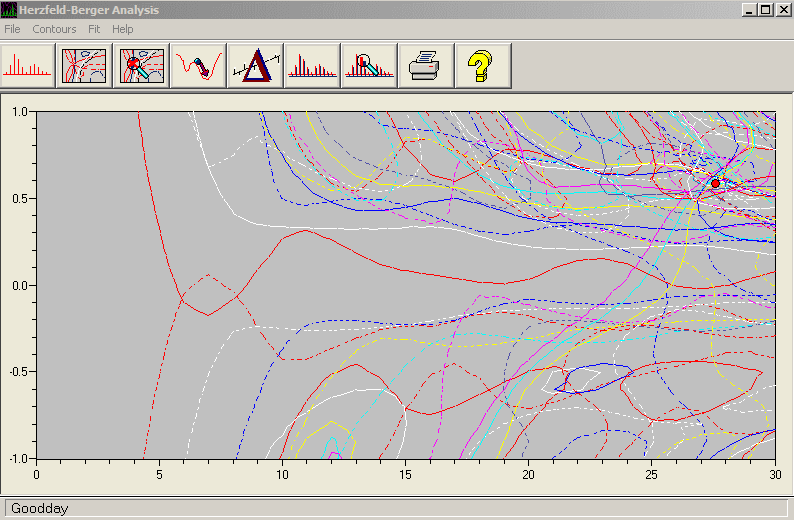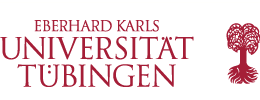[Uni Tübingen] - [Mat.-Nat. Fakultät] - [Fachbereich Chemie] - [Anorg. Chemie] - [Klaus Eichele] - [Software] - HBA

|
HBA: Herzfeld-Berger analysis program
Version 1.8.1 (20.05.2021) |
General:
- A 32 bit program that runs under MS Windows XP and above and assists in the analysis of spinning-sideband (SSB) intensities in MAS NMR spectra to yield chemical shift tensor information. HBA should also run under Linux using Wine or under Mac OS, also using Wine.
- The program uses extended Herzfeld-Berger tables, allowing input of up to 30 SSB's and values of μ in the range 0 ≤ μ ≤ 50 (the original tables have 5 SSB's and 0 ≤ μ ≤ 15)
- Parses Bruker TopSpin/XWinNMR/WinNMR and SpinWorks (by Kirk Marat, University of Manitoba) integrals or peak-picking files
- The intensities can be displayed as contour diagrams giving a very instructive visual display of the quality of the data
- Starting guesses for the iteration can be obtained automatically using a grid-search, or can be provided interactively
- Uses the Marquardt-Levenberg nonlinear least-squares fitting procedure to refine the tensor parameters
- The best fit can be graphically displayed as symbol in the contour plot or by comparison of stick spectra using experimental and calculated intensities
- The rms error can be displayed as contour map or exported to a file for use with spreadsheet software
- Interactive fitting is possible, using stick spectra representing experimental and calculated spectra
- have a look at the help file, if you need more details: PDF (3.3 MB)
This slide show demonstrates the display of contours and of stick spectra:

Changes in 1.8.1 (20.05.2021):
- New feature: the Herzfeld-Berger tables got recalculated to allow for more spinning sidebands and greater spans: spinning sideband orders in the range from -30 to +30, and values of μ in the range 0 ≤ μ ≤ 50 are now possible (compared to ± 15 ssbs and μ ≤ 30).
- New feature: using the Error Inspector, the error surface about the best fit can be exported as text file for use with spreadsheet applications.
- New feature: an error analysis of the initial guess is also included in the report.
- New feature: the output also includes the results of a moment analysis of the spinning sideband intensities.
- New feature: deal with TopSpin 3.x and 4.x peak picking files, and with SpinWorks 4 peak picking lists
- Bug fix: fixed bug in the calculation of R = marg2 /cond2 (thanks to Abil Aliev) and the calcu- lation of the error in δ33
- Neither bug nor feature: determination of the Adobe Acrobat version looks up now a registry key to determine the proper version of the Acrobat DDE server
Availability
HBA is available in two flavors:
- Download the setup program for HBA (3.9 MB). Administrator privileges may be necessary to run the installer. To install HBA, transfer the package to your PC into a directory of our choice and execute the installer. Follow the on-screen instructions.
- Download the portable version of HBA (3.6 MB) and extract the zip file into a subdirectory of your choice.
If you find this program useful and publish results obtained from this program, please include a reference to this program similar to the following:
HBA 1.8.1, K. Eichele, Universität Tübingen, 2021.
If you have problems, please feel free to contact us. Also, we would be glad to receive other feedback, e.g. bug reports, features you are missing but might be included in later versions, or questions.
Acknowledgements
- Dr. Alejandro C. Olivieri kindly provided a BASIC program that taught me how to calculate
spinning sidebands in the frequency domain. The extended tables used by HBA since 2001 are
tables that I calculated using a home-made program, based on this knowledge.
A. C. Olivieri, Solid State Nucl. Magn. Reson. 1997, 10, 19, DOI: 10.1016/S0926-2040(97)00023-4;
Olivieri, A. C. Solid State Nucl. Magn. Reson. 1998, 11, 181-187, DOI: 10.1016/S0926-2040(98)00035-6;
the extended tables used by HBA since 2001 are tables that I calculated using a home-made program, based on this knowledge;
he helped me also to figure out how to do an estimation of fitting errors:
Olivieri, A. C. J. Magn. Reson., Ser. A 1996, 123, 207-210, DOI: 10.1006/jmra.1996.0237. - He Sun (Washington University in St. Louis) suggested addition of error calculation for the initial guess.
- Dr. Abil E. Aliev (University College London) for reporting the bug in Ri.
- Prof. Dr. Cecil Dybowski (University of Delaware) for suggesting a different place for the report.
- Dr. Michael H. Frey (Jeol Inc.) for suggesting the use of command line parameters and for beta and cross-platform testing.
- My former colleague Dr. William P. Power performed the calculations to extend the original Herzfeld-Berger tables to 15 spinning sidebands and for mu to range up to 30. These extended tables were used by HBA up to 2001.
- Drs. Judith Herzfeld and Alan E. Berger kindly provided to Dr. William P. Power the code to generate the extended tables. The original reference:
J. Herzfeld, A. E. Berger, J. Chem. Phys. 1980, 73, 6021-6030. - Dr. A. Kentgens kindly provided the program HBLSQFIT, which we used prior to HBA, and which also relied on Bill Power's extended tables.
- The contouring algorithm is relatively simple but should work sufficiently well. It follows the BASIC subroutine CONREC written by Paul D. Bourke:
P. D. Bourke, BYTE 1987(6), 143-150. - The algorithms for bicubic spline interpolation and Marquardt-Levenberg non-linear least-squares procedures are adopted and adapted from:
W. H. Press, S. A. Teukolsky, W. T. Vetterling, B. P. Flannery, Numerical Recipes in C, Cambridge University Press: Cambridge 1992. - Jordan Russell provides the free installer Inno Setup, a great tool for the distribution and installation of software.
- Microsoft for providing Visual C++ 2008 Express Edition for free.
- Jochen Kalmbach for demonstrating how to statically link against the Microsoft CRT and thus get rid of VCREDIST X86.EXE.
- "chicks" for demonstrating in his pdfp PDF tools (website not available anymore) how to establish Dynamic Data Exchange (DDE) with Adobe Acrobat (Reader).
- This manual has been produced using the MiKTEX distribution of LATEX in combination with the TeXnicCenter editor.
- IrfanView has been used to process bitmapped images, and Inkscape for dealing with vector graphics.
- Chandrakala Gowda (ETH Zürich) for exploring the Mac OS installation.
[ Anorg. Chemie ] | [ Go Home ] | webm@ster | last modified: 12.07.2021

